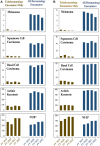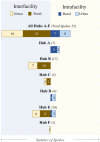Using the RE-AIM framework to assess national teledermatology expansion
- PMID: 37936881
- PMCID: PMC10627029
- DOI: 10.3389/frhs.2023.1217829
Using the RE-AIM framework to assess national teledermatology expansion
Abstract
Background: Teledermatology has been utilized in the United States Department of Veterans Affairs (VA) for decades but continues to have incomplete penetration. VA has funded an initiative to enhance access to dermatology services since 2017 to support asynchronous teledermatology for Veterans living in rural areas. As part of an ongoing evaluation of this program, we assessed the teledermatology activity between the fiscal years 2020 and 2022. We focused on the second cohort of the initiative, comprising six VA facilities and their 54 referral clinics.
Methods: We studied teledermatology programs at cohort facilities using the reach, effectiveness, adoption, implementation, and maintenance framework. We used a mixed-methods design including annual online reports completed by participating facilities and VA administrative data. When possible, we compared the data from the 3 years of teledermatology funding with the baseline year prior to the start of funding.
Findings: Reach: Compared with the baseline year, there was a 100% increase in encounters and a 62% increase in patients seen at the funded facilities. Over 500 clinicians and support staff members were trained. Effectiveness: In FY 2022, primary or specialty care clinics affiliated with the funded facilities had more dermatology programs than primary or specialty care clinics across the VA (83% vs. 71% of sites). Adoption: By the end of the funding period, teledermatology constituted 16% of dermatology encounters at the funded facilities compared with 12% nationally. This reflected an increase from 9.2% at the funded facilities and 10.3% nationally prior to the funding period. Implementation: The continued funding for staff and equipment facilitated the expansion to rural areas. Maintenance: By the end of the funding period, all facilities indicated that they had fully implemented their program for patients of targeted primary care providers. The Program Sustainability Index scores generally increased during the funding period.
Conclusions: Targeted funding to support asynchronous teledermatology implementation for rural Veterans increased its reach, adoption, and implementation, ultimately improving access. Providing program guidance with staffing and training resources can increase the impact of these programs. Ongoing efforts to maintain and increase communication between primary care and dermatology will be needed to sustain success.
Keywords: REAIM; Veterans; asynchronous care; dermatology; expansion; implementation science; rural health; teledermatology.
© 2023 Lamkin, Peracca, Jackson, Hines, Gifford, Lachica, Li, Morris, Paiva, Weinstock and Oh.
Conflict of interest statement
The authors declare that the research was conducted in the absence of any commercial or financial relationships that could be construed as a potential conflict of interest. The reviewer JB declared a shared affiliation with the authors to the handling editor at the time of review.
Figures







References
-
- Peracca SB, Jackson GL, Weinstock MA, Oh DH. Implementation of teledermatology: theory and practice. Curr Dermatol Rep. (2019) 8:35–55. 10.1007/s13671-019-0252-2 - DOI
-
- Lamkin R, Peracca S, Jackson G, Mohr DC, Hines A, Fonseca A, et al. RE-AIM framework-based implementation evaluation of teledermatology programs to serve rural veterans. Health Serv Res. (2020) 55(S1):59–60. 10.1111/1475-6773.13410 - DOI
LinkOut - more resources
Full Text Sources
Research Materials

